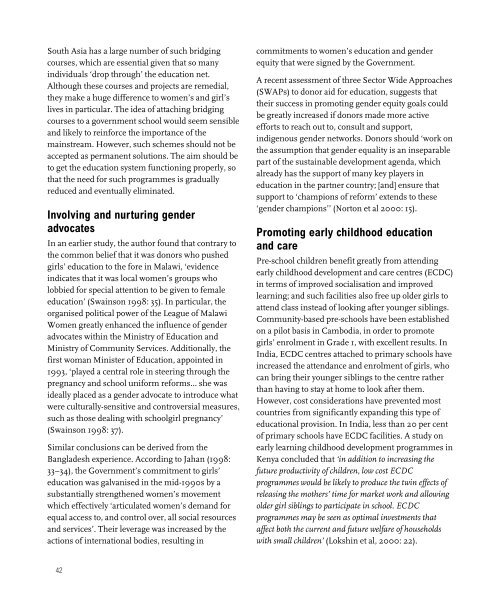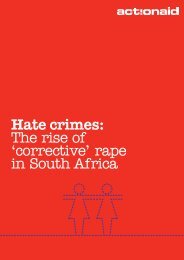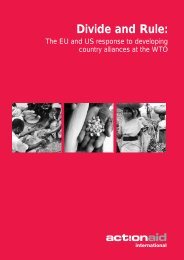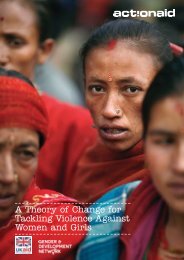A fair chance - United Nations Girls' Education Initiative
A fair chance - United Nations Girls' Education Initiative
A fair chance - United Nations Girls' Education Initiative
You also want an ePaper? Increase the reach of your titles
YUMPU automatically turns print PDFs into web optimized ePapers that Google loves.
South Asia has a large number of such bridgingcourses, which are essential given that so manyindividuals ‘drop through’ the education net.Although these courses and projects are remedial,they make a huge difference to women’s and girl’slives in particular. The idea of attaching bridgingcourses to a government school would seem sensibleand likely to reinforce the importance of themainstream. However, such schemes should not beaccepted as permanent solutions. The aim should beto get the education system functioning properly, sothat the need for such programmes is graduallyreduced and eventually eliminated.Involving and nurturing genderadvocatesIn an earlier study, the author found that contrary tothe common belief that it was donors who pushedgirls’ education to the fore in Malawi, ‘evidenceindicates that it was local women’s groups wholobbied for special attention to be given to femaleeducation’ (Swainson 1998: 35). In particular, theorganised political power of the League of MalawiWomen greatly enhanced the influence of genderadvocates within the Ministry of <strong>Education</strong> andMinistry of Community Services. Additionally, thefirst woman Minister of <strong>Education</strong>, appointed in1993, ‘played a central role in steering through thepregnancy and school uniform reforms... she wasideally placed as a gender advocate to introduce whatwere culturally-sensitive and controversial measures,such as those dealing with schoolgirl pregnancy’(Swainson 1998: 37).Similar conclusions can be derived from theBangladesh experience. According to Jahan (1998:33–34), the Government’s commitment to girls’education was galvanised in the mid-1990s by asubstantially strengthened women’s movementwhich effectively ‘articulated women’s demand forequal access to, and control over, all social resourcesand services’. Their leverage was increased by theactions of international bodies, resulting incommitments to women’s education and genderequity that were signed by the Government.A recent assessment of three Sector Wide Approaches(SWAPs) to donor aid for education, suggests thattheir success in promoting gender equity goals couldbe greatly increased if donors made more activeefforts to reach out to, consult and support,indigenous gender networks. Donors should ‘work onthe assumption that gender equality is an inseparablepart of the sustainable development agenda, whichalready has the support of many key players ineducation in the partner country; [and] ensure thatsupport to ‘champions of reform’ extends to these‘gender champions’’ (Norton et al 2000: 15).Promoting early childhood educationand carePre-school children benefit greatly from attendingearly childhood development and care centres (ECDC)in terms of improved socialisation and improvedlearning; and such facilities also free up older girls toattend class instead of looking after younger siblings.Community-based pre-schools have been establishedon a pilot basis in Cambodia, in order to promotegirls’ enrolment in Grade 1, with excellent results. InIndia, ECDC centres attached to primary schools haveincreased the attendance and enrolment of girls, whocan bring their younger siblings to the centre ratherthan having to stay at home to look after them.However, cost considerations have prevented mostcountries from significantly expanding this type ofeducational provision. In India, less than 20 per centof primary schools have ECDC facilities. A study onearly learning childhood development programmes inKenya concluded that ‘in addition to increasing thefuture productivity of children, low cost ECDCprogrammes would be likely to produce the twin effects ofreleasing the mothers’ time for market work and allowingolder girl siblings to participate in school. ECDCprogrammes may be seen as optimal investments thataffect both the current and future welfare of householdswith small children’ (Lokshin et al, 2000: 22).42
















